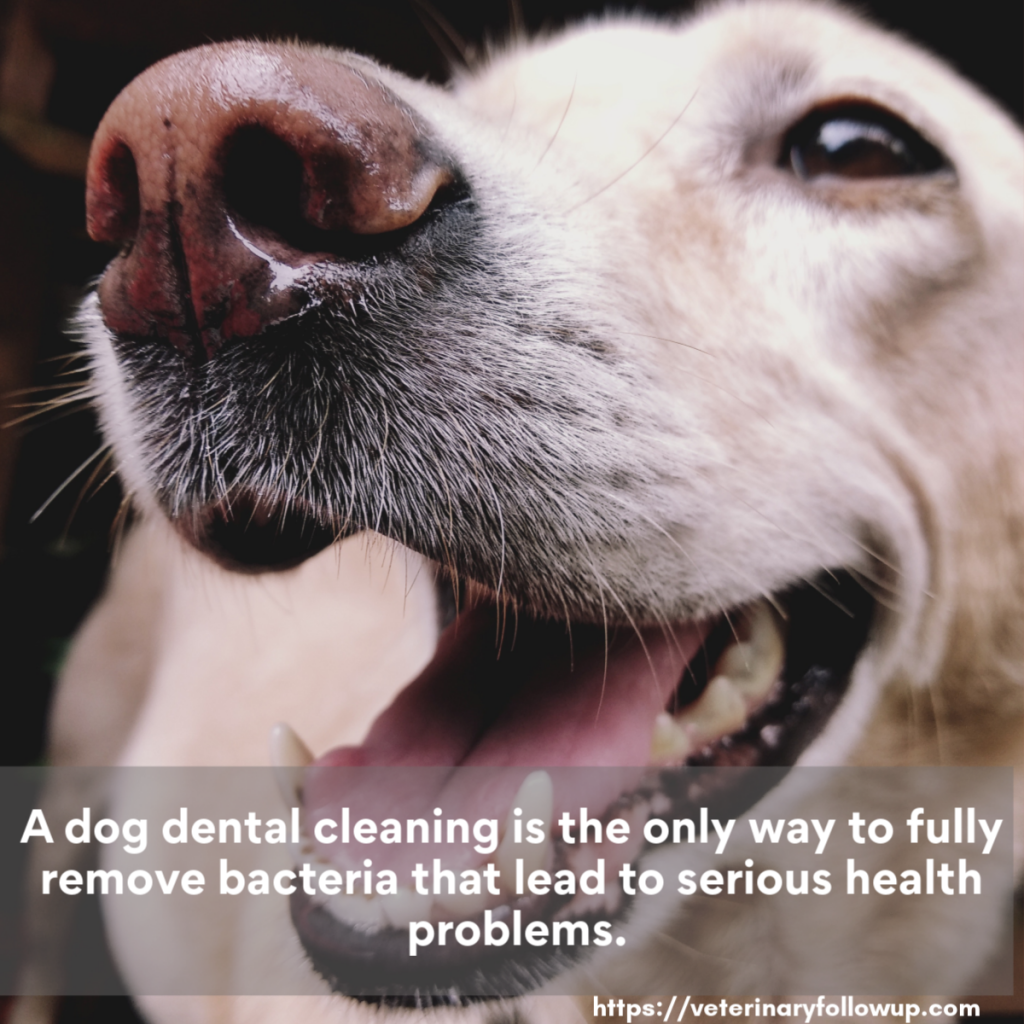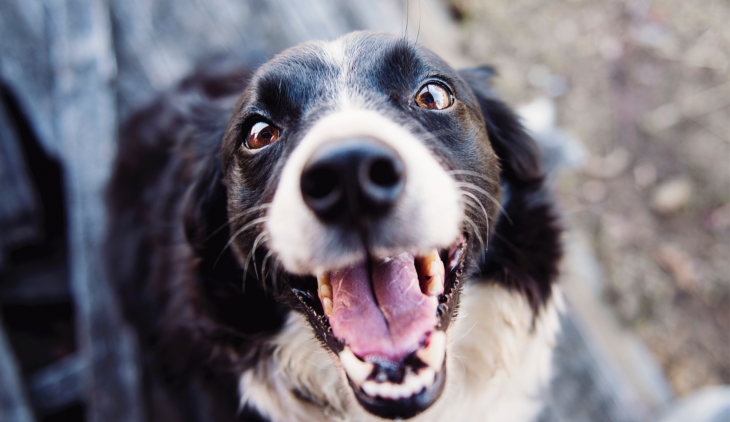Why does my dog need a dental cleaning?
Dogs, like humans, grow bacteria in their mouths that over time can cause disease. Bacteria attaches to teeth and can wear down the enamel. When that bacteria comes in contact with the gums and soft tissues of the mouth it causes inflammation and can be painful. Bacteria is also what causes bad breath. A regular dog dental cleaning can help keep your pet healthy.

Signs of Dental Disease
Often, your veterinarian will be the one to diagnose dental disease in your dog. However, there are many symptoms that your cat may show you when she has dental disease. The easiest one to recognize is halitosis (bad breath). But, there are many other signs to watch for:
- decreased appetite
- not eating dry kibble and treats (but still enjoying soft food)
- eating only with one side of the mouth
- drooling
- red gums
- bleeding from the mouth
- swelling of the face (often one side)
Dogs are experts at hiding their discomfort so you may not notice any signs despite significant discomfort.
What Is Involved In A Dog Dental Cleaning?
A veterinarian performs a full dental cleaning by first anesthetizing your dog. Your veterinarian may recommend or require bloodwork prior to the procedure to make sure your pet is healthy for anesthesia. After all, the mission statement of medicine is to “first do no harm.”
Dental Cleaning and Anesthesia
Once your dog is safely anesthetized, your veterinarian or veterinary nurse will examine all of the teeth, the gums, and the spaces in between the teeth and gums. This is the same as your dentist or dental hygienist does each time you have your own teeth cleaned. The chart produced by this examination details the health of each tooth.
X-Rays Are Vital During Doggy Dentals
Next your veterinarian may perform dental x-rays. While a lot can be learned by examining the teeth visually and with special probes, sometimes dental disease is under the gums or surrounding the tooth root. The only way to see that is by taking x-rays.
Once these steps are performed, your veterinarian will know which teeth, if any, need to be taken out. Your veterinarian will only remove teeth that are diseased and/or painful.
What is involved in the dog dental cleaning process?
The cleaning itself involves hand scaling of the teeth as well as ultrasonic scaling of the teeth above and below the gum line. This cleaning under the gum line is one of the most important aspects of a complete dental cleaning. Removing bacteria, plaque, and tartar under the gemlike not only is the first step to reversing gingivitis but also promotes healthy teeth.
Next, teeth are polished to their pearly white shine. Some veterinarians may apply gels and other products that delay the development of plaque.
Types of Dental Disease
Bacteria that attaches to teeth is called plaque. As minerals from food are trapped in that bacterial colony, it hardens and becomes tartar. You may be able to see this on your dog’s teeth. Most commonly, tartar builds up on the large premolars towards the back of the mouth. If you are concerned your cat may have tartar, don’t get bit! Ask your veterinarian to safely show you.
Plaque and Tartar Build-Up
Plaque and tartar are irritating to gums. Bacteria gets under the gums and causes inflammation that is painful (gingivitis). As gingivitis progresses into periodontal disease, the attachments of the tooth are broken down causing the tooth to be loose. Loose teeth are painful and let more bacteria take root under the gum line, worsening dental disease and necessitating extraction of teeth.
Abscesses
Left untreated, the bacteria in the mouth can cause abscesses – pockets of infection under the tooth that require emergency removal of the tooth. The bacteria can also spread to other areas of the body including the liver and the heart. When bacteria reaches the heart it can cause changes that increase your dog’s risk for heart disease.
One piece of good news is that unlike humans, dogs do not develop cavities. They do however fracture their teeth from chewing on bones or antlers, furniture, cages, and even balls and frisbees.
What can I do at home to keep my dog’s teeth as healthy as possible?
How To Brush Teeth At Home
The ideal way to keep your dog’s mouth healthy at home is to clean their teeth daily. Many dogs can be trained to have their teeth brushed in exchange for rewards. More details can be found here.
Why Brushing Daily Is Key
Importantly, once tartar accumulates brushing cannot remove it. Brushing teeth prevents future deposition. This means the best plan is to train your dog to have her teeth brushed, get a full cleaning by your veterinarian so the teeth are shiny and smooth, and then keep them that way with a daily brushing regimen.
Dental Diets
Talk to your veterinarian, some prescription dental diets can help reduce the build-up of plaque. These are specially designed diets that force your dog to chew. Regular dry kibble is not sufficient because most dogs barely chew it, if at all. Dental diets are highly recommended starting at a young age for the dog breeds most likely to develop severe dental disease including Yorkshire Terriers, Dachshunds, and Shetland Sheepdogs.
Veterinary Oral Health Council Approved Products
Finally, some treats and water additives can help reduce plaque and tartar buildup. A list of products that are proven to help can be found at the Veterinary Oral Health Council website.
Don’t neglect your dog’s teeth, a healthy mouth is key to a healthy, happy dog. Bad breath can quickly break down the relationship between a dog and his family. Don’t let that happen to your family.
Have a cat at home? Check out our post about Cat Dental Cleanings


Doggies need healthy teeth too. This is great info that I will pass on to friends as well.
I love how in-depth this post is. Dental health is so important to overall health, but it seems like too many dog owners don’t know that.
My dog has had to have several of her teeth removed because she had bad teeth when we got her. She is a chihuahua, so her breed is already plagued.
My dog has had to have several of her teeth removed because she had bad teeth when we got her. She is a chihuahua, so her breed is already plagued with bad teeth.
I need to get my dog in for a dental cleaning. We do use a water additive to help. We do need to brush his teeth more as well.
I think this is so important too. Just like us, they need to keep their mouths clean as well. I think it’s great you did a post for this. I know some don’t really know about keeping dogs teeth clean.
Thank you for all these information. It is important to take care of our pet’s health too.
This is so important….dental health is critical to our overall health, even for our pups.
Dental cleaning for our pets is truly crucial to their well-being and healthy aging. I wish it were less expensive, so more people could take advantage of it.
I need to make this a must for me and my dog. he just does not like it
Dental care also applies to our pets which few owners sometimes forget. It’s a good thing to know the symptoms jist in case or better yet prevent it from happening.
We were just talking about taking our dog to get her teeth cleaned. It is very important!